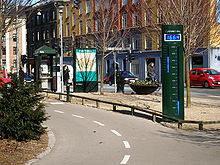- Cycling in Copenhagen
-
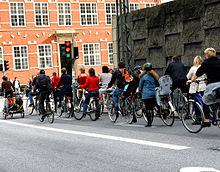 Bicycle rush hour in Copenhagen, where 37% of the population ride their bikes each day[1]
Bicycle rush hour in Copenhagen, where 37% of the population ride their bikes each day[1]
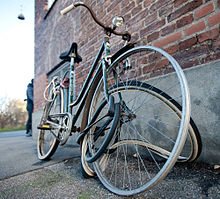 The large amount of bicycles also causes some nuisance effects: Approximately 13,000 bicycles are abandoned on public streets in Copenhagen each year.[2]
The large amount of bicycles also causes some nuisance effects: Approximately 13,000 bicycles are abandoned on public streets in Copenhagen each year.[2]
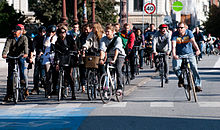 Bicyclists holding for red during rush hour
Bicyclists holding for red during rush hour
Cycling in Copenhagen is - as with most bicycling in Denmark - an important means of transportation and a dominating feature of the cityscape, often noticed by visitors.[3] The city offers a variety of favorable cycling conditions — dense urban proximities, short distances and flat terrain — along with an extensive and well-designed system of cycle paths. This has earned it a reputation as one of the most—possibly the most—bicycle-friendly city in the world.[4][5]
Every day 1.3 million km are cycled in Copenhagen,[6] with 36% of all citizens commuting to work, school or university by bicycle[7] Cycling is generally perceived as a healthier, environmentally friendly, cheaper and often quicker way around town than by public transport or car and it is therefore municipal policy for the number of commuters by bike to go up to 40% by 2012 and 50% by 2015.[1]
In recognition of Copenhagen's emphasis on bicycling, the city has been chosen by the Union Cycliste Internationale as their first official Bike City. Bike City Copenhagen covers the period 2008 to 2011 and consists of big cycling events for professionals as well as amateurs.[7]
Contents
History
Bicycles became common in Copenhagen at the beginning of the 20th century. The first separate cycle paths were established around The Lakes in 1910, when the existing bridle paths were converted into isolated cycleways to accommodate the heavy growth in cycling at the time.[8] In the 1920s and 1930s the popularity increased even further. As a spectator sport, six-day racing became popular in the 1930s. The first race was held in 1934 in the original Forum Copenhagen and its popularity topped in the 1960s.[9]
During World War II, petrol was strictly rationed, making cycling even more important as a means of transportation. During the 1940s, the first recreational bicycle routes were also developed, through green spaces in the periphery of the municipality.[10]
Starting in the 1960s, Copenhagen experienced a decline in utility cycling due to increasing wealth and affordability of motor vehicles. With the energy crisis and the growing environmental movement in the 1970s, cycling experienced a renaissance.
Although the first separate cycle paths were constructed much earlier, they did not become the norm until the early 1980s. On June 4, 1983 the Danish Cyclists' Union, at a large bicycle demonstration, gave a "Cyclist Award" to Jens Kramer Mikkelsen in the form of a two metre long curb. Mikkelsen was the head of the traffic department and later Lord Mayor. The curb was placed on the bike lane on Amagerbrogade at the corner of Hollænderdybet.[11] In the mid 1980s, Copenhagen also began to develop its first coordinated strategies for increasing cycling in the municipality. Since 1995, when the city started a monitoring system, cycling has constantly risen reaching 41% by 2004.[6]
Public bicycles
Main article: Copenhagen City Bikes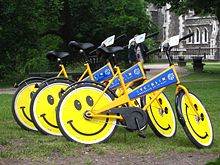 City Bike, Copenhagen
City Bike, Copenhagen
Copenhagen has a system of public bicycles, referred to as Bycykler (English: City Bikes). Launched in 1995 with 1,000 cycles, the scheme was the world's first large-scale urban bike share program featuring specially-designed bikes with parts that could not be used on other bikes. Riders pay a refundable deposit at one of 100 special bike stands and have unlimited use of a bike within a specified area.[12] The scheme is funded by commercial sponsors. In return, the bikes carry advertisements, which appear on the bike frame and the solid-disk type wheels.
The original idea behind the scheme was to reduce the theft of bicycles in the city by offering specially-designed units for free public use based on commercial sponsoring and advertising. Initial trials were however unsuccessful and it was not until the scheme was backed by the Municipality of Copenhagen together with various government ministries and some private interests that the initiative finally got off the ground. Now that it has been in operation for 15 years, it has served as an example for many other cities worldwide to adopt similar approaches.[13][14]
Plans are now underway to modernise the bike-sharing system. A recent international call for proposals led to two winning designs, Openbike and Myloop, selected in December 2009. The Copenhagen authorities are now expected to combine the best features of each for a completely new system by 2013.[15]
Municipal bicycle policy
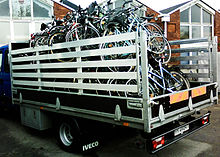 Copenhagen authorities vehicle, used to pick up more than 13,000 abandoned bicycles in Copenhagen[2]
Copenhagen authorities vehicle, used to pick up more than 13,000 abandoned bicycles in Copenhagen[2]
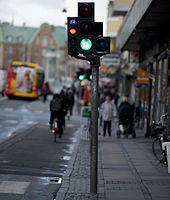 Segregated traffic light for automobiles and cyclists
Segregated traffic light for automobiles and cyclists
Targets
The City of Copenhagen has formulated a Cycle Policy 2002-2012, stating the following targets:[6]
- the proportion of people cycling to workplaces in Copenhagen shall increase from 34% to 40%
- cyclist risk of serious injury or death shall decrease by 50%
- the proportion of Copenhagen cyclists who feel safe cycling in town shall increase from 57% to 80%
- cyclist travelling speed on trips of over 5 km shall increase by 10%
- cycling comfort shall be improved so that cycle track surfaces deemed unsatisfactory shall not exceed 5%
Initiatives
To reach the targets set, the City of Copenhagen employ a number of measures, seeking to make cycling an even more attractive option.
New cycle paths and greenways
Copenhagen's network of cycle paths is continuously being extended. A plan from 2006 has a prioritized list of new paths to be constructed in the period 2006-16.[16] In the same time the city's network of greenways, still in its infancy, will be developed, aiming at increasing traveling speed over longer distances while at the same time improving safety and comfort.
New bridges
A number of new pedestrian and cycle bridges across the main harbour as well as canals are planned, to make for more direct routes, increasing overall traveling speed and improving safety. Recently completed new bridges include Bryggebroen across the harbour, connecting Vesterbro and Islands Brygge, and Åbroen over the heavily used artery Åboulevarden. There are plans for a new bridge across the harbour[17] as well as a number of smaller bridges across canals, which will improve access to Christianshavn and in particular Holmen. Another planned pedestrian and cycle bridge, to be designed by Icelandic-Danish artist Olafur Eliasson, will cross the southern mouth of Christianshavn Canal, facilitating passage along the waterfront.[18]
Improved bicycle parking
A number of projects have been launched to ease Copenhagen's notorious shortage of bicycle parking spaces, particularly at transport hubs. These include plans for 2,500 new bicycle spaces, placed sunken 'bicycle beds' in connection with a refurbishment of Nørreport Station[19][20] and an architectural competition for a new 7,000 bicycle parking facility above the rail tracks at Central Station, due to open in 2013.[21]
Anti-bike theft chips
To combat problems with bike thefts, the City of Copenhagen has entered into cooperation with the Technical University of Denmark to develop a scheme for tracking stolen bikes by GPS. An RFID chip is affixed to bicycles and parking attendants carry GPS-equipped RFID scanners which will send an e-mail with the location to the owner if a bicycle is registered as stolen. 5,000 chips were been handed out free of charge in a pilot project.[22][23] However, the project was abandoned in March, 2011 after being found ineffective.[24]
Influence
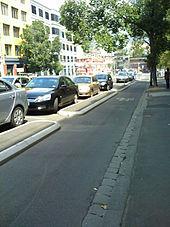 Copenhagen-style cycle paths in Melbourne.
Copenhagen-style cycle paths in Melbourne.
Copenhagen's well-developed bicycle culture has given rise to the term copenhagenization. This is the practice of other cities adopting Copenhagen-style bike lanes and bicycle infrastructure.[25] An example of a city which has introduced bike lanes with inspiration from Copenhagen is Melbourne,[26] where they are referred to as 'Copenhagen lanes'.[27] In 2007 Copenhagen-based Danish urban design consultant Jan Gehl was hired by the New York City Department of Transportation to re-imagine New York City streets by introducing designs to improve life for pedestrians and cyclists.[28] In this connection, Gehl took NYC planning chief Amanda Burden and transportation czar Janette Sadik-Khan on a bike trip around Copenhagen to show them what could be done for New York.[29] Former British transport minister Andrew Adonis has also cycled the streets of Copenhagen in search of inspiration.[30] As a result of Russian president Dmitri Medvedev's favorable impressions of Copenhagen's biking system during his visit to Denmark, 14 city bikes were sent to St Petersburg at the beginning of June 2010 where they will be available to citizens on an experimental basis. Medvedev believes the city bike approach could reduce traffic congestion in the city.[31] The Danish pavilion at the 2010 World Expo in Shanghai has been specially designed by BIG Architects. It allows visitors to gain experience of cycling in Copenhagen by taking one of its 300 city bikes along the cycle paths which are incorporated throughout the structure.[32]
See also
- Cycling in Denmark
- Utility cycling
- Segregated cycle facilities
- Modal share
- Danish Cycling Federation
- Danish Cyclists Federation
- Cycling Embassy of Denmark
- Copenhagen City Bikes
References
- ^ a b "Grønne cykelruter". Københavns Kommune. http://www.kk.dk/Borger/ByOgTrafik/CyklernesBy/KonkreteProjekter/OevrigeProjekter/GroenneCykelruter.aspx. Retrieved 2009-01-05.
- ^ a b Stelling, Irene (2009-09-16), "Cykelvrag sendes til Afrika" (in Danish), avisen.dk, http://avisen.dk/cykelvrag-sendes-til-afrika_114175.aspx
- ^ The Top 10 cities to visit in 2009, TimesOnline
- ^ "Best City for Cyclists: Copenhagen". TreeHugger. http://www.treehugger.com/galleries/2010/04/best-of-green-cars-transportation.php?page=12. Retrieved 2010-04-09.
- ^ Tyler Brûlé, "Metropolis now", Financial Times, June 11, 2010. Retrieved 13 June 2010.
- ^ a b c "Bicycle Account - 2004Street". Copenhagen Municipality. http://www.walkandbikeforlife.org/Articles/Copenhagen%20City%20Of%20Cyclists.pdf. Retrieved 2009-10-30.
- ^ a b "Bike City Copenhagen". Københavns Kommune. http://www.visitcopenhagen.com/content/tourist/what_to_see_and_do/events/event_calendar/major_event_-_information?EventID=590. Retrieved 2009-01-05.
- ^ "Brief History about Copenhagen". Copenhagen Portal. http://www.copenhagenet.dk/CPH-History.htm. Retrieved 2009-11-18.
- ^ "seksdagesløb". Gyldendal. http://www.denstoredanske.dk/Livsstil,_sport_og_fritid/Sport/Cykelsport/seksdagesl%C3%B8b. Retrieved 2009-06-23.
- ^ "Grønne Cykelruter i København". Københavns Kommune. http://www.trafikdage.dk/td/papers/papers00/Dag2/papers/2710.pdf. Retrieved 2009-10-30.
- ^ "Copenhagen Lanes Celebrate 25 Years". copenhagenize.com. http://www.aok.dk/teater/gasvaerket. Retrieved 2009-10-31.
- ^ Free City Bike Schemes, Søren B. Jensen, City of Copenhagen, Conference Proceedings, Amsterdam 2000
- ^ "Bycyklens historie", Bycyklen København. (Danish) Retrieved 8 June 2010.
- ^ Louise Skov Andersen, "Københavns bycykler skal skrottes", Ibyen.dk, 28 May 2008. (Danish) Retrieved 8 June 2010.
- ^ Julie Ring-Hansen Holt, "Nye teknologiske bycykler på vej til København", Ingeniøren, 15 December 2009. (Danish) Retrieved 10 June 2010.
- ^ "Cykelstier og cykelbaner". Københavns Kommune. http://www.kk.dk/Borger/ByOgTrafik/cyklernesby/Cykelstier.aspx. Retrieved 2009-10-30.[dead link]
- ^ "Telescopic bridge set for Copenhagen". World Architecture News. http://www.worldarchitecturenews.com/index.php?fuseaction=wanappln.projectview&upload_id=12632. Retrieved 2009-10-31.
- ^ "Cirkelbroen by Eliasson". Dezeen. http://www.dezeen.com/2009/11/11/cirkelbroen-by-olafur-eliasson/. Retrieved 2009-11-14.
- ^ "Det nye Nørreport hylder mylder". Politiken. http://ibyen.dk/gadeplan/article830473.ece. Retrieved 2009-11-14.
- ^ "Nørreport comp reaches end of the line". World Architecture News. http://www.worldarchitecturenews.com/index.php?fuseaction=wanappln.projectview&upload_id=12688. Retrieved 2009-11-14.
- ^ "Nye cykelpladser til Hovedbanegården". Berlingske. http://www.berlingske.dk/koebenhavn/nye-cykelpladser-til-hovedbanegaarden. Retrieved 2009-11-14.
- ^ "Free bike theft prevention". Jyllands Posten. http://jp.dk/uknews/article1824920.ece. Retrieved 2009-10-31.
- ^ "Free The Chips Are Up In Copenhagen". Copenhagenize.com. http://www.copenhagenize.com/2009/06/chips-are-up-in-copenhagen.html. Retrieved 2009-10-31.
- ^ "Anti-theft bike project ditched". The Copenhagen Post. http://www.cphpost.dk/news/local/87-local/51258-anti-theft-bike-project-ditched.html. Retrieved 2011-05-19.
- ^ "Media Release: Copenhagen Comes To Swanston Street". Press release. http://www.legislation.vic.gov.au/domino/Web_Notes/newmedia.nsf/b0222c68d27626e2ca256c8c001a3d2d/6755f8108f4ff605ca2570700001e087!OpenDocument. Retrieved 2009-01-05.
- ^ "Inner: Swanston RMIT to Melbourne University". Bicycle Victoria. http://www.bv.com.au/change-the-world/11629/. Retrieved 2009-06-23.
- ^ "Copenhagen Lanes - FAQ's". Bicycle Victoria. http://www.bv.com.au/change-the-world/40269/. Retrieved 2009-10-31.[dead link]
- ^ "Danske cykelstier i New York". DR Online. http://www.dr.dk/Nyheder/Penge/2007/10/05/064448.htm. Retrieved 2009-01-05.
- ^ "Gehl on Wheels". New York News & Features. http://nymag.com/news/intelligencer/40345/. Retrieved 2009-06-23.
- ^ "British Transport Minister in Copenhagen". copenhagenize.com. http://www.copenhagenize.com/2009/09/british-transport-minister-in.html. Retrieved 2009-06-23.
- ^ "Bycykler sendes til Rusland", Danmarks Radio P4. (Danish) Retrieved 8 June 2010.
- ^ Mike Chino, "BIG Unveils Spiraling Cycling Pavilion in Shanghai", Inhabitat. Retrieved 8 June 2010.
External links
- Copenhagenization in the Danish capital from CNN's *Future Cities* series
- CopenhagenCycleChic.com
- Copenhagenize.com
- Copenhagenize.eu Copenhagenize Consulting
- Copenhagen: City of Cyclists
- Cycling-Embassy.dk Cycling Embassy of Denmark
- Cycling map of Copenhagen
Categories:- Cycling in Copenhagen
- Cycling by city
- Urban planning in Denmark
Wikimedia Foundation. 2010.

